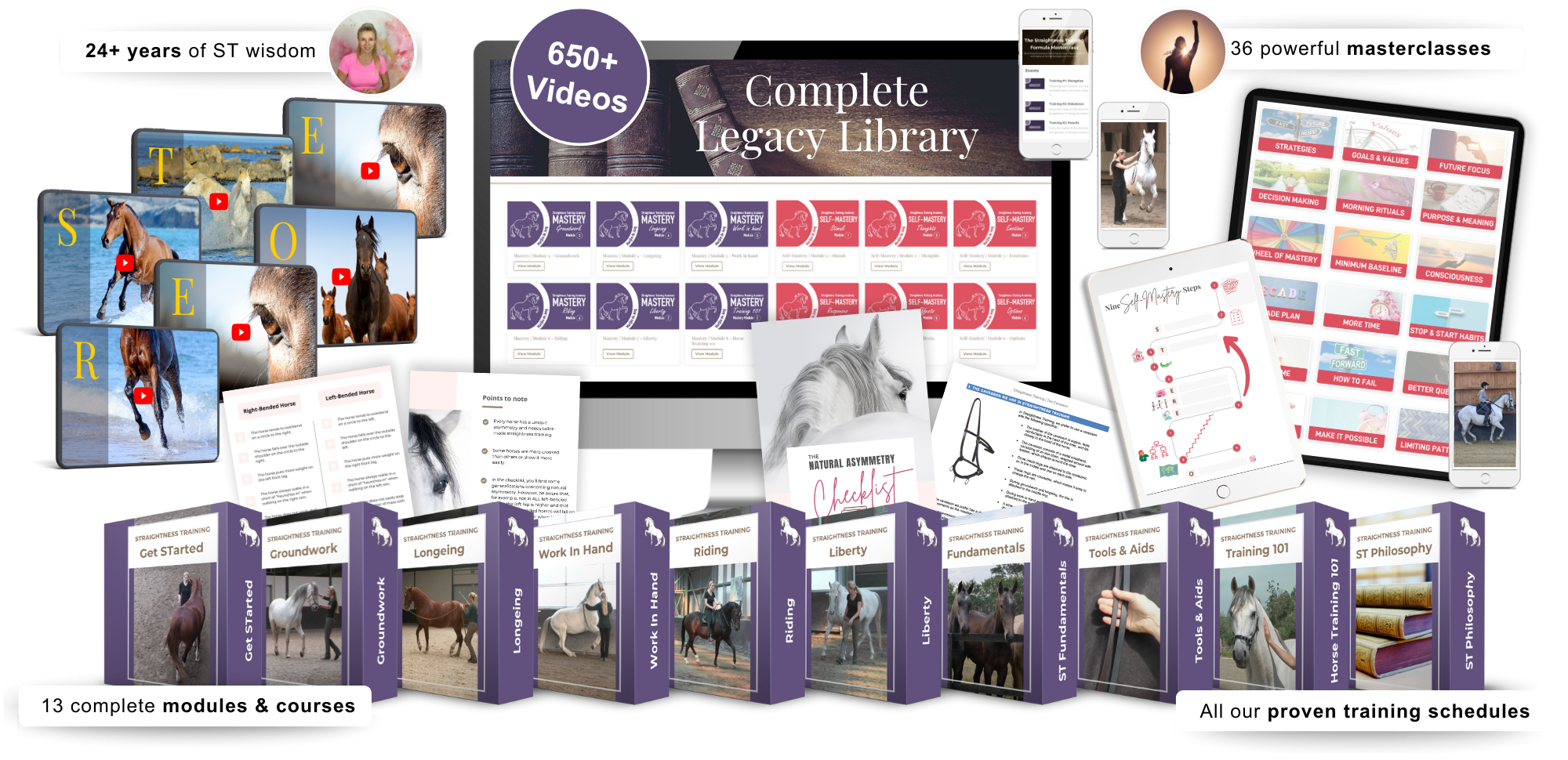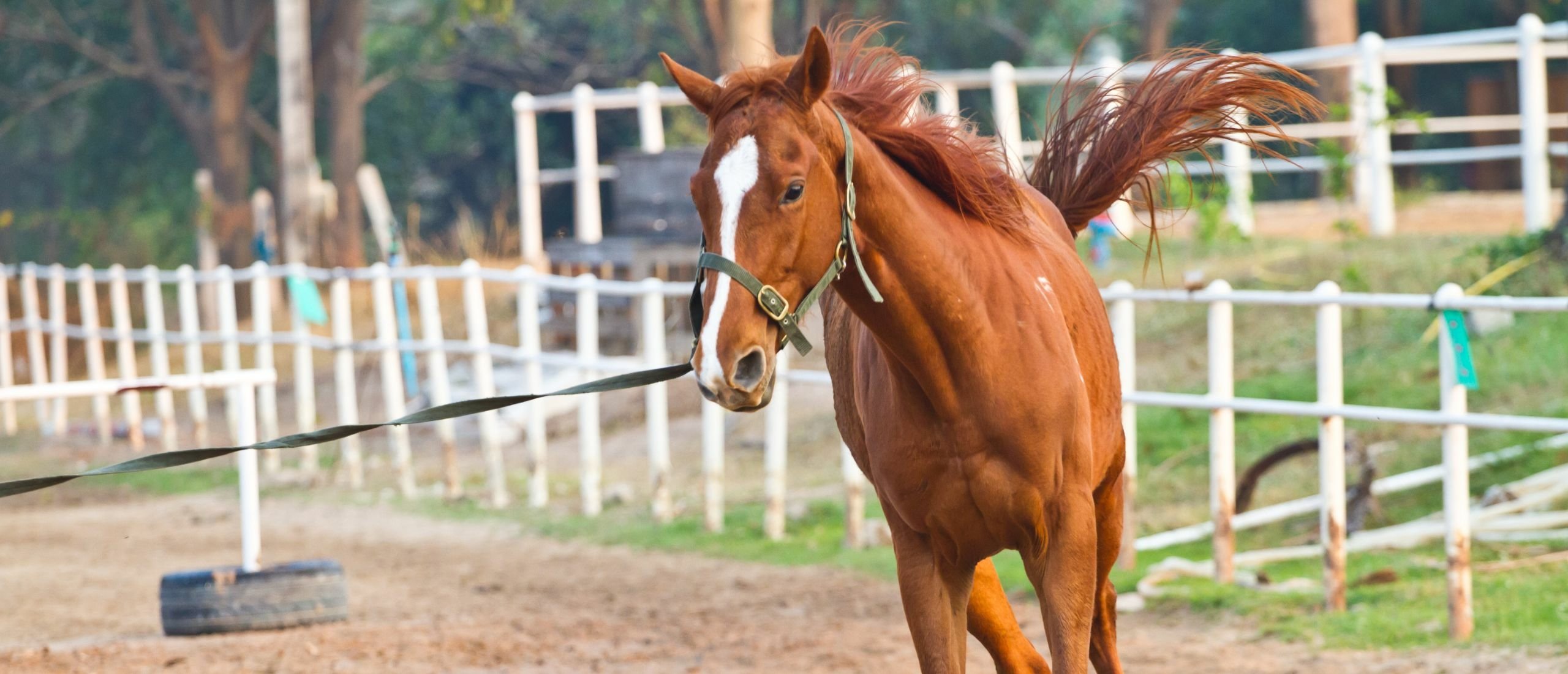
Circles, yes or no?
Circles, yes or no. That is the question when horses are in rehab. Many veterinarians give the advice not to move a horse on small circles when he's recovering from a leg injury, but to walk him in straight lines instead.
Discover the truth behind this advice in this video, and what vets often overlook when it comes to circles and natural asymmetry:
Not moving on a circle is a good advice if people let their horses ‘fall’ on the in- or outside shoulder.
Falling
A horse that is out of balance often falls over the outside or on the inside shoulder:
- In falling over the outside shoulder, the center of mass (red dot) shifts towards to the outside front leg (picture on the left).
- In falling on the inside shoulder, the center of mass shifts towards the inside shoulder (picture on the right).
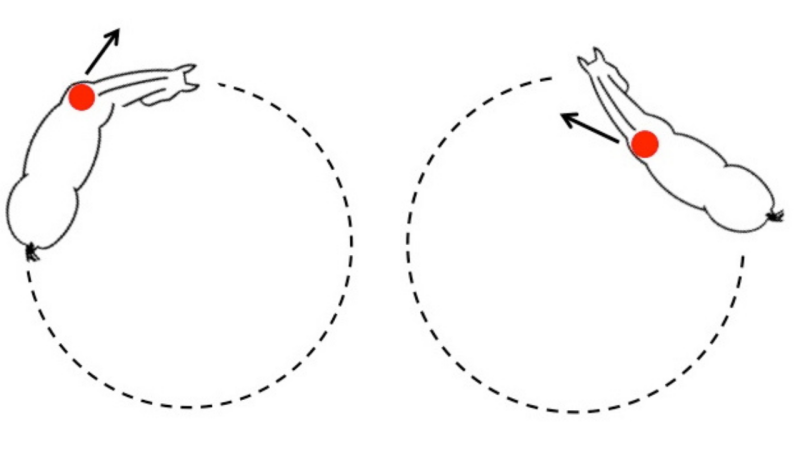
If the horse falls on a particular shoulder, this front leg has to carry most of the horse’s body weight, and that’s not a good idea if this leg has to recover.
Why is a horse falling?
An untrained horse often has a ‘short’ side and a ‘longer’ side. This is called natural asymmetry.
For example a natural right bended horse has short muscles on the right, and longer muscles on the left side of his body.
This horse cannot stretch his short muscles that are on the right side of his body and will therefore not be able to bend his body to the left.
As a result, this horse will chose to fall on the shoulder and swing out in behind.
Falling in & swinging out
When a right bended horse moves to the left, he starts to swing out with the hindquarters and the outside hind leg starts to step very much besides the track of the outside front foot.
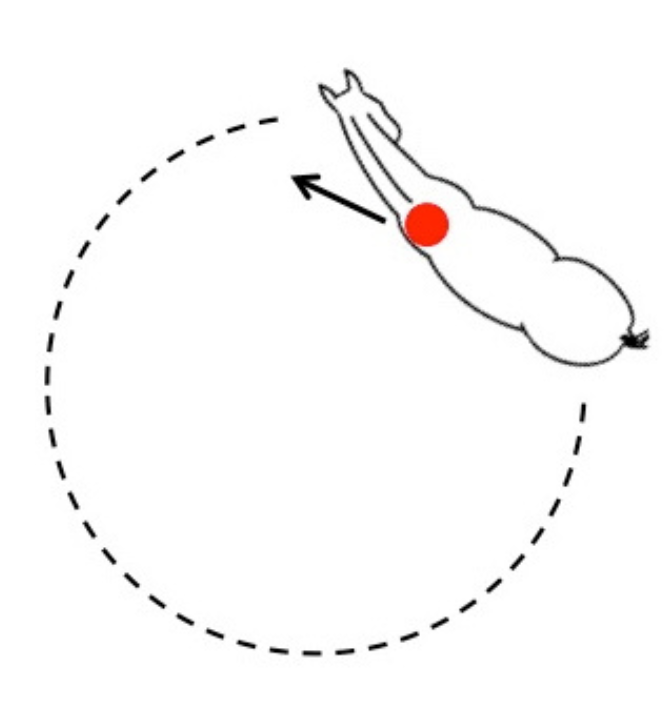
This shearing out can cause friction in the joint that connects the spine with the hind legs. So this is not a healthy way to move on a circle, especially when the horse's left front leg is recovering from an injury.
But there is a difference in ‘falling’, ‘swinging out’ and ‘turning’. A horse can fall in or out to stay on the circle, he can swing out in behind, but he can also turn, by bending his body and spine accordingly to the size of the circle.
However, an untrained horse will be very asymmetrical in body and limbs, so he cannot move on circles naturally, therefore we have to stretch the very contracted muscles on one side of his body and encourage the long muscles to contract on the other side of this body and then we teach him to turn. To do so we start on the ground, by doing groundwork in walk, without the extra weight of the rider.
Now imagine that you start to learn the splits today yourself, that’s also not a quick fix, that will take some days/weeks/months. But if we take the time it takes to teach our horse to turn on a circle, rather than falling or swinging out, we can make him supple, strong, healthy and fit and can ride him until an old age.
Turning
When a horse turns, the bend in the spine will influence the position of the pelvis and as a result the inside hip will come forward which causes the inside hind leg to step under (green arrow) the center of mass (red dot).
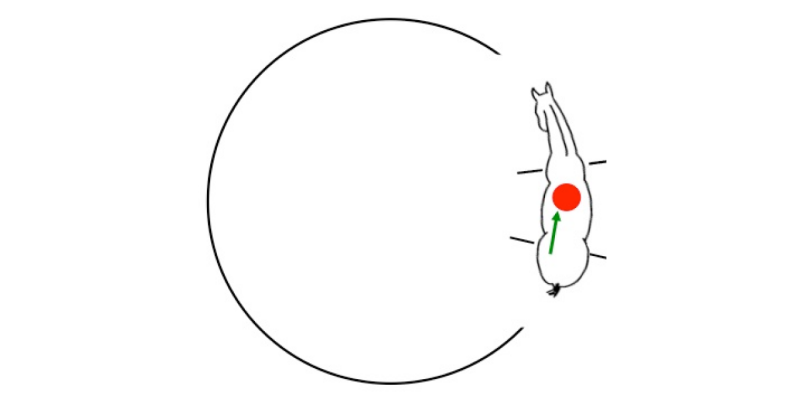
When the center of mass is in the correct position – so imagine a rider, it should be under the rider, and not shifted towards one of the shoulders – the inside hind leg will connect with this center of mass and because of that he can support the body. And this support is necessary to free the inside shoulder from weight and to allow the horse to move with a supple back.
So a horse that turns properly will not lean/fall on the inside shoulder and he will not swing out. On a circle the horse has to bend accordingly to the size of the circle and the smaller the circle, the more bend in the body is required and the better support of the inside hind leg is required.
On the circle the inside hind leg will start to support the body weight. By nature the horse will carry most weight on the front legs, in a 3/5 ratio, that means when a horse weighs 1000 pounds, 600 pounds is carried by the front legs and 400 by the hind legs. On the circles you help the horse to start moving in horizontal balance, where front and hind legs each carry 50% of the body weight. So this way the front leg would start to carry less weight, than when you only allow the horse to move freely on straight lines in natural balance.
Falling over the outside shoulder
Another argument to not move on small circles is that a bended back and spine would be a weak back, therefore exercises should aways be done with very little bend. And there’s an argument that lateral bend would lead to inverted rotation.
Both arguments are valid in certain occasions:
Most left bended horses are also right handed causing the center of mass to shift towards the right shoulder (and vice versa in a right bended horse).
On the circle this leads to centrifugal forces where the horse shows the tendency of falling over the outside shoulder.
When the rider wants to counteract these forces and fight the symptoms of increasing circles, he might start to overbend the neck to keep the horse on the circle.
Another symptom that often occurs, is that the rider slides with the saddle and own weight towards the outside of the back of the horse and will sit mainly on the outside seat bone. And this imbalance of the rider will weaken or stiffen the back and bring the horse out of balance even more.
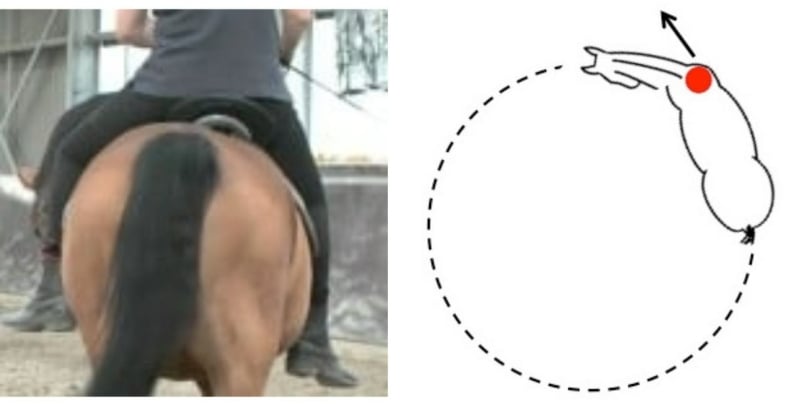
So when a rider trains without rebalancing the horse and with overbending of the neck, small circles indeed won’t lead to proper use of the back and proper rotation.
Stelling, neck bending and bending in the body
Let’s have a closer look to the stelling of the head, the neck bending and the bending in the body:
- With the stelling we positioning the skull to the left or right and the skull is connected to the first neck vertebrae.
- With the stelling we can influence the neck bending and the neck with it’s 7 neck vertebrae is the most flexible part of the spine, because it has no ribs and no legs attached. So the neck can easily bend more than in proportion with the body. If the horse is very flexible, he can even scratch his inside hip or hind leg with his mouth.
- The spine in the body consists of 18 chest vertebrae, 5 or 6 lumbar vertebrae, and 5 connected croup vertebrae. The 18 chest vertebrae form a relatively stiff area. The first 8 pairs of ribs are connected to the top of the first 8 chest vertebrae and at the bottom they are connected to the sternum. Not a lot more flexibility can be expected from the other 10 vertebrae and 10 ribs. So in this area of the ribcage more rotation is required because the limitation of the bend possibility. The 6 (or 5 with some Arabian horses) lumbar vertebrae behind the saddle are a bit more flexible, because there’s no connection with the ribs. The 5 croup vertebrae are not flexible at all, because they are all connected together to the scarum. In this video you can see the vertebrae (and for more written info about the skeleton of the horse click HERE):
So the neck vertebrae are the most flexible part of the spine. How a horse reacts on your request to bend the neck depends on the amount of schooling:
Imagine a person driving a car: when a novice car driver starts to move the head to look at the back seat, he easily takes the wheel with him, so the car goes off track. Only when you become more skilled as a car driver you are able to move your head independently from your hands on the wheel, so you can look in behind whilst keeping the wheel in the same position.
It’s the same with novice and untrained horses: when you ask for stelling and neck bending, they have the tendency to also move their body and shift the center of mass. So we need to teach the horse to do this without using his whole body.
Advanced and well-educated horses can show and give more bend in the neck without losing their balance and falling on the shoulder. Especially when they have developed a strong ‘think inside’ and when they curl around you themselves they might offer a bit more neck bend in proportion to the body bend.
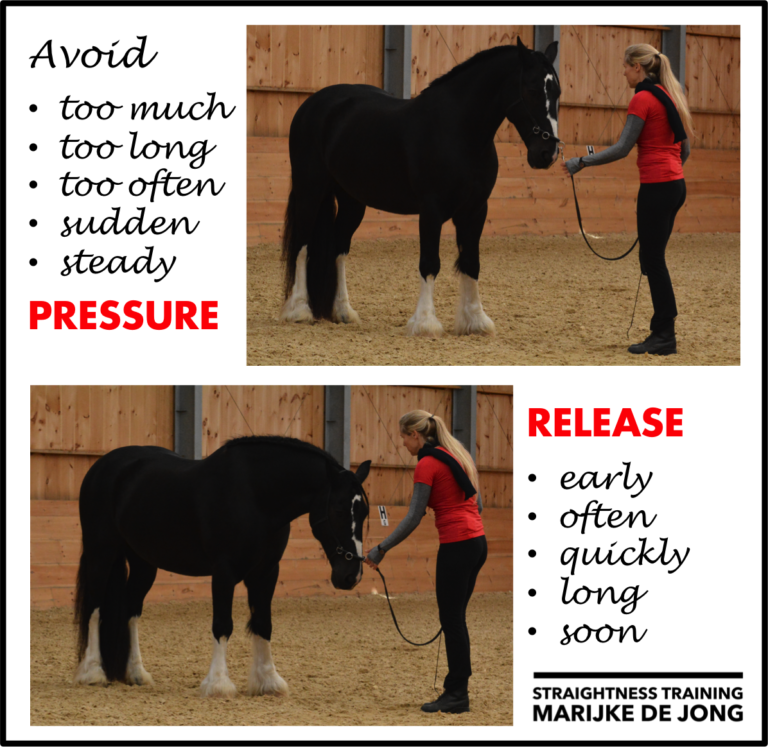 How a horse reacts on your request to bend the neck also depends on how we ask for neck bending:
How a horse reacts on your request to bend the neck also depends on how we ask for neck bending:
When we ask too much, too fast, or with sudden or steady pressure with the inside rein, this approach easily brings the horse out of balance. So we have to make sure to release our hand the moment the horse gives us the stelling and bending and yields.
Back to the question…
Are circles okay or not, in general and with a horse that is recovering from an injury?
As you can see, small circles are not ‘always’ ‘right’ or ‘wrong’ and lateral bend doesn’t ‘always’ lead to a weak back or inverted rotation. It depends on the natural asymmetry in the body and limbs and the amount of imbalance, and on the phase of education of the horse and the amount of muscles he has developed, and it also depends on the rider how he’s influencing the horse with his seat and reins and if he’s aware of the cause or fighting the symptoms.
However, a more important question is: why do we do circles?
Start with why
Why do we do circles?
Because it’s a great exercise to counteract the natural asymmetry and to rebalance the horse.
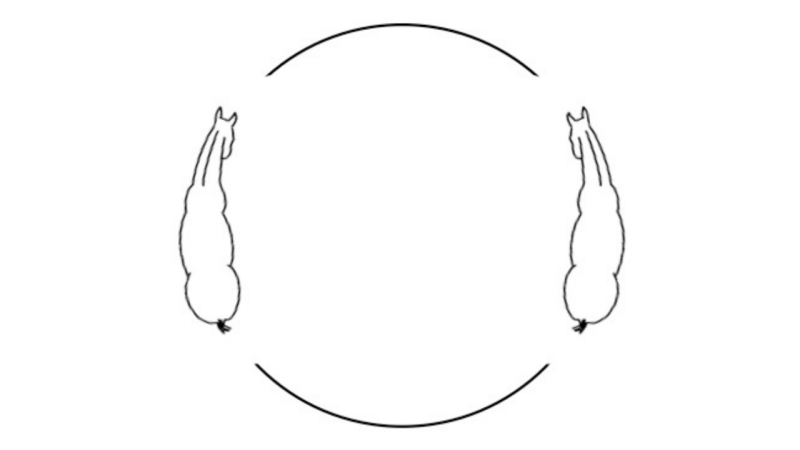
It’s also a great exercise to prepare the inside hind leg to support the body and to take weight, in order to free the fragile front legs.
Throughout the centuries, riding masters and riders have been dealing with the phenomenon of natural asymmetry and many wrote about the benefit of the lateral bending, which is the first of the six keys in Straightness Training. And the circle is the perfect exercise to create an equal lateral bend to both sides.
And when it comes to horses who are recovering from an injury and are ready to start working again: ‘rest rusts‘, as we say in the Netherlands, because all fluids in the body that bring healing materials to the places where it’s needed will stagnate, if the horse doesn’t move. So doing groundwork with circles is a great way to start moving and to supple body and limbs and to improve his coordination. Because walking with the horse in a halter on a straight line doesn’t make the horse more supple and it also won’t shift the weight away from the front legs. And many horses with an injury in one part of the body start to compensate in other parts of the body, so stretching exercises on the circle can eliminate blockages that has arisen from this compensation.
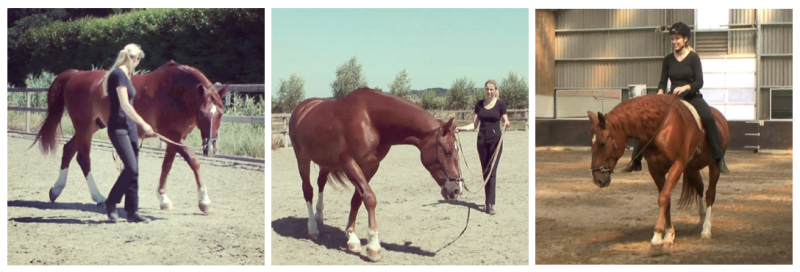
So in ST we strive for the ideal of symmetry and balance, that is what we are searching for.
If you want to learnmore about Straightness Training so you can make an informed choice on the direction you wish to take on your horsemanship journey, join my free masterclass here »

